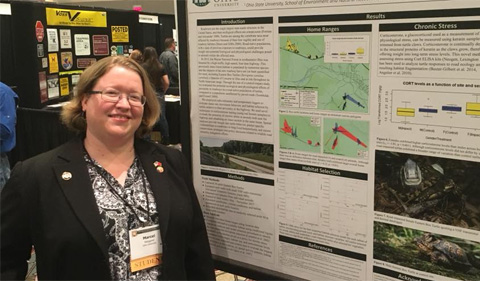Ecology and Evolutionary Biology graduate student Marcel Weigand’s research shows positive news for Eastern box turtles whose habitat was bisected by construction of the U.S. 33 bypass through the Wayne National Forest.
“In 2013, the Wayne National Forest in southeastern Ohio was bisected by a high-traffic, high-speed highway, affecting a road-naïve population of Eastern Box Turtles (Terrapene carolina carolina), a Species of Concern in Ohio and at risk throughout its North American range,” Weigand writes in her paper.
Overall, they found no differences in home range sizes and habitat selection between a group of road-impacted turtles and an unimpacted group. “While we found higher corticosterone levels in females, we found no significant differences based on site. These results suggest that proximity to roads has potentially limited influence on Eastern Box Turtles. Although this is positive news for the turtles, roads remain likely to contribute to population declines through direct mortality.”
Weigand, advised by Dr. Viorel Popescu, Assistant Professor of Biological Sciences, presented her research “Evaluating potential effects of proximity to roadways in a road-naïve population of turtles” at three professional meetings in January: Midwest Fish and Wildlife, held Jan. 29-31 in Milwaukee; Ohio Fish and Wildlife Management Association, held Jan. 25-26 in Columbus; and Society for Integrative and Comparative Biology, held Jan. 4-8 in San Francisco, where she was also awarded a Grant-in-Aid of Research by the Society.
Co-authors included Dr. Christopher Tonra, Assistant Professor in Avian Wildlife Ecology at Ohio State University, and Ryan Wagner, a student in the Wildlife and Conservation Biology program.
Abstract: Roadways are the single largest man-made structure in the United States, and their ecological effects are conspicuous. Turtles are among the vertebrate taxa most affected by roads because of their low vagility and use of roadway habitats. In 2013, the Wayne National Forest in southeastern Ohio was bisected by a high-traffic, high-speed highway, affecting a road-naïve population of Eastern Box Turtles (Terrapene carolina carolina), a Species of Concern in Ohio and at risk throughout its North American range. Using a control-impact study, we evaluated potential ecological and physiological effects of proximity to roadways, including habitat selection, home range size, and corticosterone as a proxy for chronic stress. Comparing road-impacted and unimpacted road-naïve turtles in otherwise similar patches of the same forest provided us with unique insight into animal behavior and the ecological impacts of the highway. The juxtaposition of traditional selection studies with hormone bioassays allowed us to take a comprehensive approach to understanding animal/road ecology, and the novel use of keratin for corticosterone testing provided an interesting temporal facet. Overall, we found no differences in home range sizes and habitat selection between sites, although females demonstrated significantly larger ranges than males. While we found higher corticosterone levels in females, we found no significant differences based on site. These results suggest that proximity to roads has potentially limited influence on Eastern Box Turtles. Although this is positive news for the turtles, roads remain likely to contribute to population declines through direct mortality.





















One Comment